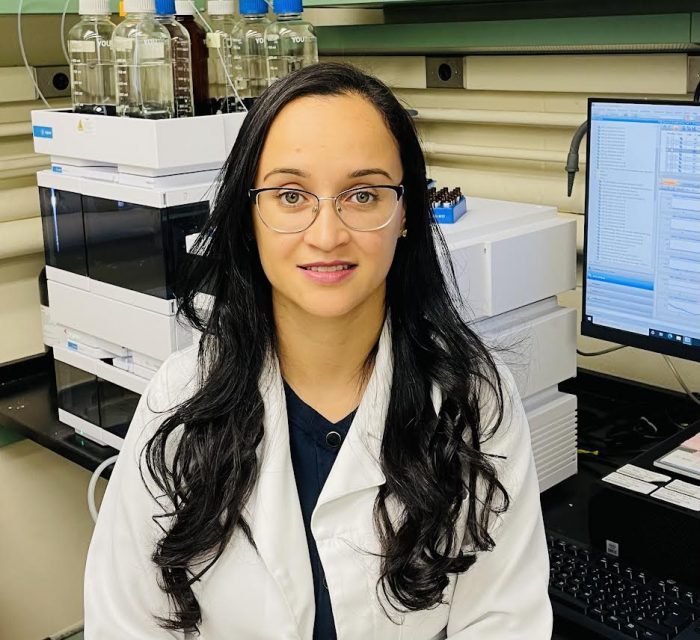By Daniel Dunaief
When people are immunocompromised, exposure to what might ordinarily be a harmless fungus can cause significant health problems.
Researchers in the laboratory of Maurizio del Poeta, Distinguished Professor in the Department of Microbiology and Immunology at the Renaissance School of Medicine at Stony Brook University, have been looking to create new treatments and develop vaccines against these fungi.
Working with a team of scientists at Stony Brook, research scientist Nivea Pereira de Sa, who joined del Poeta’s lab in 2018 as a postdoctoral researcher, recently published research in the journal mBio about potential anti-fungal drugs that target a key enzyme in the fungus Aspergillus fumigatus.
Without the enzyme, the fungus can’t cause disease and the host defenses have time to eliminate it even if the host is immunodeficient.
Working with Michael Airola, Assistant Professor in the Department of Biochemistry and Cell Biology at SBU, Pereira de Sa started out by trying to find the structure of sterylglucosidase, an enzyme that is a molecular key for the fungus during infection and that aids in its ability to adapt to environmental changes such as low oxygen levels and changes in pH.
Pereira de Sa learned how to do x-ray crystallography from Airola, a process that reveals the structure of compounds.
In an email, Airola described Pereira de Sa as an “expert” in the technique.
Airola called the research “one of the most exciting projects” he’s worked on and hopes the group can translate the results into the clinic. A talented biochemist, Pereira de Sa is also an “expert in so many different scientific areas,” Airola wrote, which he described as “rare.”
Pereira de Sa also determined the structure of the same enzyme for Cryptococcus, another invasive and potentially harmful fungus. The enzymes in both fungi have a high degree of similarity.
Pereira de Sa expressed satisfaction at the application of such work. “Every time I get a crystal structure, it’s so amazing,” she said. “I love doing that.”
Pereira de Sa started screening potential compounds to inhibit sterylglucosidase in Aspergillus,
Del Poeta’s lab coordinated the design and testing of these inhibitors with Iwao Ojima, Distinguished Professor in the Department of Chemistry and Director of the Institute of Chemical Biology and Drug Discovery at Stony Brook.
Refining potential drugs
Ojima’s group is synthesizing derivatives of the hits Pereira de Sa found and she will start tests outside a living organism, or in vitro, soon.
Ojima has synthesized several compounds using computer-assisted drug design. He is currently developing several inhibitors that scored high on his computational molecular docking analysis and will synthesize two to three dozen potential small molecules.
Ojima, who partnered with Pereira de Sa in this study, “greatly appreciates her and her seminal contributions to this project,” he wrote in an email. She made critical contributions to the study that ensured its success and Stony Brook is “very fortunate to have her as a leader in this project.”
Ojima plans to identify highly potent inhibitors individually for Aspergillus and Cryptococcus separately, and then will try to find and develop broad spectrum inhibitors based on those compounds.
The need for a treatment has increased dramatically as the number of immunocompromised patients has increased.
Invasive aspergillosis can have mortality rates above 90 percent. The World Health Organization last October released its first ever list of health threatening fungi, which includes Aspergillus.
Pereira de Sa suggested two possible uses for this inhibitor. It could work as a treatment, knocking down the virulence of the fungus or it could contribute to the development of a vaccine.
In strains with a mutated enzyme, a mouse model has full protection against infection.
Getting a vaccine approved through the Food and Drug Administration for immunocompromised individuals might be challenging, she said. Several studies would be needed to confirm its safety.
Del Poeta added that the vaccine his lab has developed is effective alone when heat killed, reducing the threat a live virus with a defective enzyme might pose to an immunocompromised patient. Del Poeta has been developing a vaccine for cryptococcus and aspergillus and is testing it for other fungal infections as well.
‘A beautiful cause’
Del Poeta described Pereira de Sa as a key contributor to his lab, who is methodical, systematic and hard working.
The program she is developing will take years to go to clinical trials, he added.
Del Poeta met Pereira de Sa in 2017, when he visited Brazil and spoke with her mentor, Daniel de Assis Santos, who gave her an enthusiastic reference.
After meeting with her for only five minutes, del Poeta offered her a job.
“I will never forget her face: surprised, joyful, excited and she could not hold back some tears,” del Poeta described.
Del Poeta is thrilled with his choice, as she has gone above and beyond his expectations.
Born and raised in Belo Horizonte, Brazil, Pereira de Sa lives in East Setauket with her husband Rodrigo Carvalho da Silva, who is an airplane mechanic.
She enjoys Long Island, particularly during the summer, when she goes hiking, visits parks, kayaks and goes paddle boarding.
Pereira de Sa is encouraged by the progress in her work and is hoping her research contributes to future treatments.
“We are developing tools to help people,” she said. “It’s a beautiful cause I’m fighting for.”
She said the mortality rate from these fungal infections is “very high,” especially because a fungus like Aspergillus is ubiquitous.
“The fungus is present everywhere,” she said. “We are inhaling the spores of it every day.”
The invasive fungal disease starts in the lungs and spreads to the rest of the body, including in the brain, which can cause seizures.
Pereira de Sa recognizes the urgency of developing an effective treatment.
“We need some solutions and we need it now,” she said. “We are not prepared to fight fungal infections” on a large scale.





